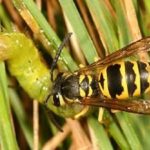
Eastern yellowjacket wasps are important predators that feed on caterpillars. (Photo by T. Murray, MA)
What are yellowjackets? The term yellowjacket is commonly used to describe ground nesting social wasps. Two common wasps with similar behavior are the native Eastern yellowjacket wasp, Vespula maculifrons and the exotic German yellowjacket wasp, Vespula germanica. Both species are important predators in their native ecosystems where they prey on a variety of plant eating caterpillars. The Eastern yellowjacket is common in Indiana.
If yellowjackets are beneficial insects, why are they considered pests? When yellowjacket wasps locate their nests away from people, they help protect trees from caterpillar pests, and eat the flesh of dead animals. When nests are located near people, they can sting. Unlike honeybee workers who die after their barbed stinger gets stuck in your flesh, yellowjacket wasps can sting multiple times. I actually counted 9 stings when from a single unfortunate wasp that flew up my pant leg when I mowed over the nest in my back yard in my shorts just two weeks ago in late August.
Yellowjacket wasps are very active in late summer. This nest, located near a highly trafficked area poses a stinging threat.
Yellowjacket wasp life cycle. Yellowjacket wasps spend their winters as mated queens. In spring the queen makes a new nest to produce workers that she guards. After workers mature they help the queen expand her nest and make more female workers, queens and males. At the peak of their activity in late summer and early fall, each nest can contain well over 1000 cells. For this reason, running over a nest with a lawnmower can be a rather unpleasant experience. If nests are made in structures, such as the wall void of a home, the nests can be quite dangerous.
How to control yellowjacket wasp nests. When yellowjacket wasps are in structures it is best to call a trained professional to minimize stinging risks. While stings can be painful to most people, some people can have an allergic reaction that can be lethal if not treated quickly. Ground nesting yellowjacket wasps can be treated with minimal risk by applying the insecticide at night when all the wasps are tucked into their nests. But don’t even think about doing this if you know you have an allergy to wasps.
Spraying yellowjacket wasps at night with a foaming aerosol spray in accordance with the label directions is an effective and safe way to control this pests. Yes, that is me spraying the same nest that was home to the wasp that flew up my shorts. Sometimes, revenge can be sweet.